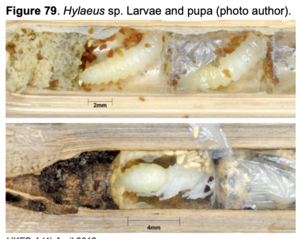Brood Cell Microcosm

The nests of solitary wasp species (including everybody's favorite pollen-collecting solitary wasps "the bees") are known as brood cells. Depending on the species observed these cells can be found in underground chambers, hollow twigs, sculpted with mud, or even crammed inside abandoned snail shells. These cells that female wasps provision with a food source (prey or pollen) and lay an egg in, don't stop interacting with the environment once they are sealed. The microcosm formed when a mother wasp seals a finished brood cell is home to a plethora of co-evolved relationships that can beneficially or negatively affect the health of the egg/larvae found in the nest. Brood cell mutualists and parasites span across many taxa; from yeasts and bacteria that negatively affect the health of the occupant, all of the way to mutualistic prostigmatic mites that fend off/eat infectious fungi.
Solitary Wasp Life Cycle and Development:
Solitary wasps are any of the Aculeate Hymenoptera that are not social, meaning they don't have a reproductive division of labor with queens laying eggs and workers.. working. Instead, female individuals create their own nests (broods) and provision these nests with a food source on their own. The food source each species of solitary wasp collects is highly variable. Some individual species or groups of closely related species can be extremely specialized to one type of food item. Examples of this are the clade Anthophila (The bees) which all provision their brood cells exclusively with pollen, or the family Pompilidae which only provision their nests with spiders. Once a brood cell is provisioned to perfection the solitary wasp will lay an egg and seal the cell.
Members of Brood Cell Microcosm:
Bacteria and Yeast:
Fungi:
Nematodes:
Mites: